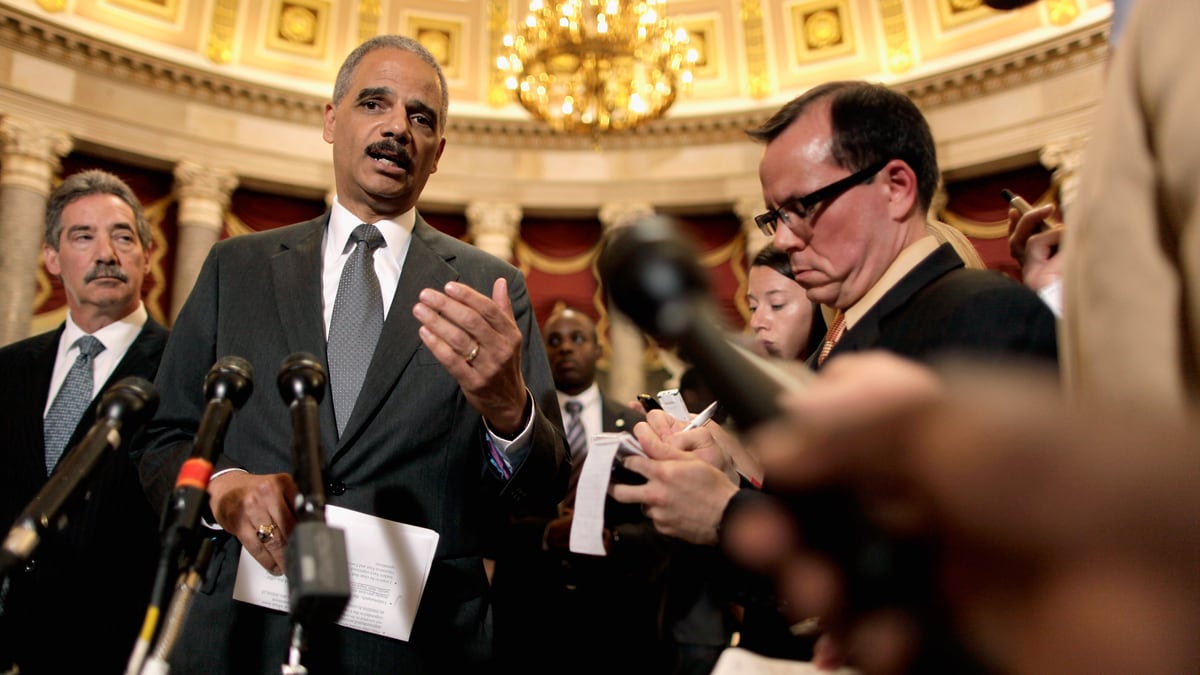So…what is Operation Fast and Furious?
Fast and Furious was a “gun-walking” operation conducted by the Phoenix, Arizona branch of the Bureau of Alcohol, Tobacco, Firearms, and Explosives (or the ATF) from 2009 and 2011. The idea was to encourage licensed Arizona gun merchants to sell firearms to known criminals, in the hope that law enforcement would be able to then trace the weapons from Arizona as they crossed the border into Mexico, slowly making their way into the hands of bloodthirsty Mexican drug cartels. Fast and Furious was part of a broader series of investigations called Project Gunrunner, all of which had the collective long-term goal of halting the flow of weapons to criminals in Mexico. Arizona gun sellers sold about 2,000 weapons to “straw” buyers, often young kids lured by a reported $100 per transaction. The ATF lost track of an estimated 1,700 of those guns. One buyer alone is reported to have purchased 600 of the weapons. In another incident, one buyer went on a spree, snapping up 34 firearms in about three weeks.
Yikes. When did this all begin?
ADVERTISEMENT
Project Gunrunner began in Laredo, Texas, in 2005 and was expanded in 2006. Operation Fast and Furious was operational from 2009 to 2011.
And this was the first time the feds had tried this?
No. In fact, two similar gun-walking operations, including one run out of the same Phoenix-area office that oversaw Operation Fast and Furious, were conducted under President George W. Bush. The first, Operation Wide Receiver, ran from 2006 to 2007, and tried to make use of the same chain of gun buyers, smugglers, and middle men who tossed deadly weapons up the ladder to cartel enforcers. Both Wide Receiver and the 2007 probe allowed guns to make their way across the border in a manner similar to Fast and Furious.
So what went wrong this time?
One hardly knows where to start: the history of Fast and Furious is in many ways a litany of disasters. Guns showed up where they were not supposed to be. A cache of more than 40 firearms sold through Lone Wolf Trading Company in Glendale, Arizona – an important outlet for Operation Fast and Furious – wound up in Texas in January 2010. In a separate incident, a gun runner was let off by the ATF so that he would lead them to higher-ups – a plan that was thwarted when ATF agents discovered too late that the men he led them to were already informants for the FBI. Kenneth E. Melson, then acting director of the ATF, announced in August 2011 that he was stepping down from his post as more details on Fast and Furious leaked out.

There’s more, though. What about Brian Terry?
Right. On December 14, 2010, Customs and Border Protection Agent Brian Terry and other officers were on patrol in the Arizona desert when gunfire erupted. In the firefight that ensued, Terry and the other agents took aim at the Mexican gunmen first with non-lethal weapons and then with live ammunition. Terry was killed in the fight. Afterward, two AK-47 assault rifles were recovered from the site of the encounter –and both guns had been sold as part of Operation Fast and Furious. While ATF officials at first cited an FBI ballistics report that showed that a gun sold through Fast and Furious was not the murder weapon, later reports showed that it was actually not conclusive.
Following Terry’s death, President Obama ordered the Justice Department’s inspector general to conduct an investigation of Fast and Furious.
Sounds like a mess. What did Mexico think of this?
Apparently, they had no idea. When Mario Gonzalez, brother of an influential Mexican prosecutor, was tortured and killed in 2010, Mexican and American law enforcement officials were stunned. The Mexican police, however, did not know the whole story. Central to the case were the killers’ weapons – assault rifles that had slipped across the border under the watchful but passive eye of American border agents. The Mexican attorney general has said that even while Americans were allowing guns to come into her country, she only heard about the program after it hit the press. “At no time did we know or were we made aware that there might have been arms trafficking permitted,” Marisela Morales said in an interview. “In no way would we have allowed it, because it is an attack on the safety of Mexicans.”
In a 2011 article by the Los Angeles Times, Mexican officials said that upward of 150 Mexican citizens had been killed or wounded by guns that were sold and transported with the knowledge of the ATF. The Times acknowledged that the figure was unconfirmed.
OK, so where does Rep. Darrell Issa come in?
Issa, a Republican, is chairman of the House Oversight and Government Reform Committee, and has made it a personal crusade to bring Fast and Furious to a wider audience. The battle has often taken on overtly political tones. Democrats see Issa’s vigorous pursuit of the case as motivated purely by political aims, and characterize the oversight committee’s probe as little more than an attempt to shame Holder and the president. Issa himself has said that he thinks the Obama administration is the “most corrupt” in the history of the American presidency.
The case has been effective in firing up other prominent Republicans, however. NRA President Wayne LaPierre called Fast and Furious “the biggest cover-up since Watergate” at the Conservative Political Action Conference in Orlando in September of last year. Influential Republican lawmakers including Florida Sen. Marco Rubio and Texas Sen. John Cornyn have called for Attorney General Eric Holder to resign, with Cornyn saying in June that Holder had “left me with no choice but to join those who call for you to resign your office.”
Well, should Holder resign? How much was he involved?
Depends on who you ask. The point Issa has hammered away at most vigorously is the question of when the attorney general—whose department has responsibility for the ATF—knew about Fast and Furious and when he knew it. While Holder at first said the he only became aware of Fast and Furious in the spring of 2011, evidence later emerged that he may have been aware of at least the rudiments of the operation as much as 10 months before that.
Any chance there are some documents that could clear this up?
Issa has claimed that the Obama administration and the Justice Department have been intractable when it comes to procuring documents and testimony related to gun-walking. The White House disagrees, saying that they have been highly accommodating, turning over 7,600 pages of documents and devoting time to 11 congressional hearings.
The latest and most politically volatile development, however, was Issa’s decision on June 20 to have the oversight committee vote on recommending a contempt citation for Holder – a vote that passed strictly along party lines. House Speaker John Boehner said that the House would vote on holding Holder in contempt unless he turned over documents related to the operation.
Contempt citation…what’s that?
Congressional committees have the power to compel production of documents relevant to their investigations, and Issa has made full use of that power as he has conducted his probe of Fast and Furious. But there are documents from one key date that Issa still wants, and it is these documents have caused him to pursue a contempt citation against Holder.
Though the Department of Justice has handed over thousands of documents already, the ones Issa wants most are internal communications from February 4, 2011. That’s the date of a letter in which the DOJ said they did everything they could to stop the flow of illegal weapons to Mexico– something that was demonstrated to be not true once news of Fast and Furious broke.
Though it is not clear exactly what these documents may involve, it seems likely that they consist of the Department of Justice’s reaction to the backlash against Fast and Furious. That is, what Issa may be after is not so much what happened with the guns, but what happened inside Holder’s house once they discovered that news of the failed operation had gotten out.
But Obama cut off the document handover by invoking executive privilege. What’s the deal with that?
Executive privilege, though not a power explicitly enumerated in the Constitution, has been upheld by the courts as the president’s right when he believes that the disclosure of information may cause harm to the executive branch, or when national security is at stake. After receiving a letter from Holder on June 19, 2012 that recommended that the president invoke executive privilege, Obama did so. His decision to invoke executive privilege in regard to the Fast and Furious documents is his first use of the power during his presidency. For sake of comparison, George W. Bush invoked executive privilege 6 times, and Bill Clinton invoked it 14 times.






